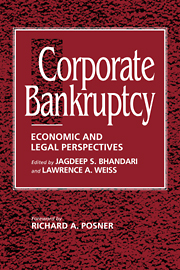Book contents
- Frontmatter
- Contents
- List of tables and figures
- Foreword by the HONORABLE RICHARD A. POSNER
- Preface
- Part I The role of credit
- Part II Bankruptcy as a reflection of the creditors' implicit bargain
- Part III Beyond the basic creditors' bargain
- Part IV Workouts or bargaining in the shadow of bankruptcy
- Part V Alternatives to bankruptcy and the creditors' bargain
- Part VI Experience of other countries
- Index
Part I - The role of credit
Published online by Cambridge University Press: 10 December 2009
- Frontmatter
- Contents
- List of tables and figures
- Foreword by the HONORABLE RICHARD A. POSNER
- Preface
- Part I The role of credit
- Part II Bankruptcy as a reflection of the creditors' implicit bargain
- Part III Beyond the basic creditors' bargain
- Part IV Workouts or bargaining in the shadow of bankruptcy
- Part V Alternatives to bankruptcy and the creditors' bargain
- Part VI Experience of other countries
- Index
Summary
A corporation finances its operations (working capital and long-term assets) by issuing a combination of equity and credit. A firm may compensate suppliers of equity capital with dividends and, eventually, with proceeds from the firm's liquidation. The right to either, however, is residual and subject to any creditor claims. The only noncontingent right of an equity investor is the right to vote on matters of concern to the firm; most importantly, the right to elect the firm's managers. In contrast to its relationship with equity investors, a firm agrees to compensate creditors with fixed payments. A creditor's right to payment generally is noncontingent and, in the event a firm defaults on a fixed obligation, the unpaid creditor may begin collection proceedings pursuant to applicable nonbankruptcy law.
In a world without bankruptcy law, a collecting creditor might seize assets critical to the corporation's operation. A bankruptcy petition temporarily halts all legal proceedings against the debtor corporation and provides a period of time, or breathing space, for the corporation to renegotiate its fixed obligations. The nature and propriety of this breathing space is the subject of much of the literature on bankruptcy. However, the logical starting point for a book on corporate bankruptcy is an explanation of debt itself, because without debt's fixed obligations there would be no threat of destructive collection and no firm would need bankruptcy protection.
The first chapter in the book is the Nobel Memorial Prize Lecture “Leverage” by Merton Miller. In this lecture Miller uses recent concern about leveraged buyouts in the United States to explain the inherent advantages of fixed obligations to a firm – advantages that go beyond any benefits that result from United States income tax laws.
- Type
- Chapter
- Information
- Corporate BankruptcyEconomic and Legal Perspectives, pp. 1 - 2Publisher: Cambridge University PressPrint publication year: 1996



